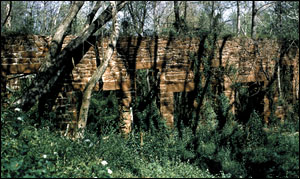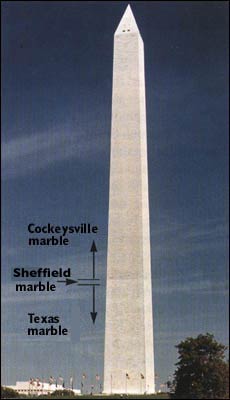

Old quarry building site at Seneca Creek, Montgomery
County, Maryland, built of red Seneca sandstone.
|
During the "brownstone era," from about 1840 to about 1880, red Seneca sandstone (called Manassas Sandstone by geologists) was extremely popular in Washington. This stone of Triassic age (more than 200 million years old) crops out along the Potomac River in the Triassic Lowland province from Seneca to just east of Point of Rocks, Md. Red Seneca sandstone ranges from reddish brown to a deep purplish brown. It is brightly colored and fairly easy to carve when cut but darkens and hardens on exposure to air. Seneca sandstone is generally fine grained and uniform, and it does not scale when exposed to weather.
Several quarries supplied this red sandstone to the city. The best known is about 20 miles up the Potomac on the Maryland shore just west of Seneca Creek. The remains of the quarry and of the adjacent Seneca Basin, where canal barges were loaded with stone for shipment up or down the canal, may still be seen, although they are on private land. The ruins of a quarry building, which housed saws and machinery for finishing the stone, stand nearby.
|
The masonry locks of George Washington's "Potowmack" Canal at Great Falls, Va., are largely constructed of this Seneca red sandstone, as are many of the locks, lockhouses, and other structures of the Chesapeake and Ohio Canal, which were built between 1828 and 1850. The three - arched aqueduct that carries the C&O Canal over Seneca Creek is built of this stone cut near the site, as are the capstones on the Union Bridge that carries the aqueduct and MacArthur Boulevard over Cabin John Creek in the Washington suburb of Glen Echo, Md. Seneca sandstone was also used for some of the backing for the marble of the Washington Monument.
The first important government building to be constructed of the sandstone was the carved and turreted main building of the Smithsonian Institution (the Castle), designed by James Renwick. The sandstone quarried for the Smithsonian building was described originally as lilac gray; now it is a dark red. This building, in the romantic style, was constructed between 1847 and 1857. Seneca sandstone is also prominent in the Capitol floors and Rotunda door frames.
|
Marble subsequently replaced sandstone as the most popular building stone in Washington. The first marble came from a layer of stone called Cockeysville Marble, from quarries in the Piedmont province at Cockeysville and Texas, Md., just north of Baltimore. The marble at Cockeysville is fine grained and contains significant amounts of magnesium. It is a clear white stone with a few pale streaks or bands, which give an effect of pale gray. The marble from the Texas quarry is white and coarser grained and is nearly pure calcium carbonate. Some specimens of both marbles contain veins and pockets of mica and pyrite, which can stain the marble if it is exposed to the elements.
Three different kinds of marble were used in the construction of the Washington Monument, which was delayed by several problems. According to the city plan drawn up by Pierre L'Enfant, the site for the Washington Monument was at the intersection of an east - west line through the center of the Capitol and a north - south line through the center of the White House. This site was quickly abandoned because it was too swampy to support an adequate foundation for the monument. Instead the monument was built slightly east of the original location; a small granite marker stands on the original site proposed by L'Enfant. The first 152 feet of the monument, built between 1848 and 1854, is faced with marble from Texas, Md. Work stopped when funds ran out. When construction was about to resume in 1876, the builders discovered that the foundations were inadequate and the monument was sinking and tilting. To stabilize and straighten the monument, wider subfoundations were constructed to a depth of nearly 37 feet.
In 1879 work began again on the upward projection of the monument, and
four courses or rows of white marble from Sheffield, Mass., were laid
above the Texas marble. However, because of difficulties with timely delivery
and quality control, the contract with the Sheffield quarry was annulled
in 1880 [information on Sheffield marble updated 08-11-04 on the basis
of data obtained from the National Park Service (http://www.nps.gov/nama/mortar/mortar.htm#wamo)
and the U.S. Army Corps of Engineers (http://www.usace.army.mil/inet/usace-docs/eng-pamphlets/ep870-1-21/toc.htm)].
The upper part of the monument was finished with Cockeysville marble.
The three marbles used in the monument can be distinguished by color differences.
|

Arrows indicate use of
three different kinds of marble
|
The white Maryland marbles were the first building stones to be shipped in quantity into Washington by rail. After 1840, as the expanding railway system increased the accessibility of stone from other parts of the country, the use of local building stone declined although Seneca sandstone continued to be shipped down the C&O Canal until the 1890's. The Federal Government contracted for marble from a quarry in Hawkins County, Tenn., in 1848. Marble from this quarry, one of the first areas in the country where marble was quarried commercially, was used in many buildings in Washington, most notably in three interior stairways in the wings of the Capitol built around 1855. Marble from Lee, Mass., was also used in the two wings of the Capitol built in the mid - 1850's. The columns of these wings are made from Maryland marble.
Starting in the 1850's, granite quarried at Dix Island, Maine, was shipped by sea to Washington and was used for facings and columns in the Treasury Building. Granites from New England, Georgia, and North Carolina and marbles from Vermont, Tennessee, and Georgia were used for almost all government buildings after the Civil War until the First World War.
Around 1900, limestone of Mississippian age (about 345 million years old) from near Bedford, Ind., was introduced. The first government building to be faced with this stone was the old Department of the Interior building at 18th and F Streets NW (now the General Services Administration), which was completed in 1917. Indiana limestone has become the most popular building stone of official Washington because it is relatively easy to work and is resistant to weathering. It is used in all Federal buildings in the area called "Federal Triangle," between Pennsylvania and Constitution Avenues and 14th Street.

Peace Monument
|
Minnesota granite, rarely seen in Washington's government buildings before World War II, is now being used more frequently. This material serves as steps and trim around the Museum of American History of the Smithsonian Institution and is used in fountains in the Ellipse on Constitution Avenue. Some of these granites have been dated by the U.S. Geological Survey as 3.5 billion years old, the oldest rocks in North America.
Other building stones used in Washington include a white marble from Carrara, Italy, which has been used in statuary such as the Peace Monument at Pennsylvania Avenue on the west side of the Capitol. The Italian government made a gift of 3,000 tons of three different types of marble from the Carrara district for use as facing for the Kennedy Center for the Performing Arts. Travertine from Italy is used as facings and trim for office buildings, such as those on the south side of Pennsylvania Avenue between 17th and 18th Streets NW.
NEXT
|
Introduction || Washington's Geologic Setting || Acid Rain in Washington
Descriptions and Origins of Selected Principal Building Stones of Washington
Building Stones of Washington Walking Tour || About This Publication
Online Version 1.0
This page is https://pubs.usgs.gov/stones/stones4.html
Maintained by Publications Services
Last revised 8-11-04 (krw)


